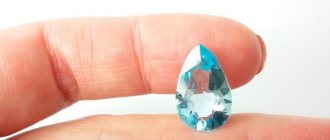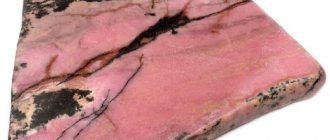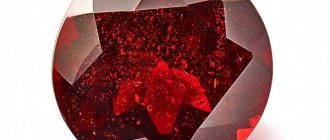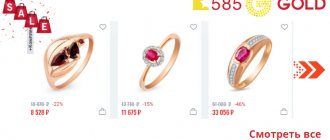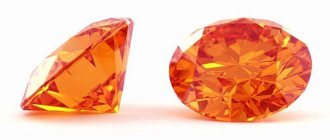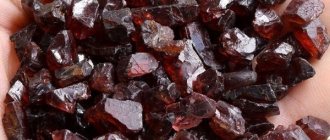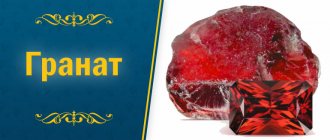Garnet is a stone as ancient as it is covered in legends. There were legends about the magical properties of pomegranate in all the places where this stone was found. Its habitat is very wide: there are deposits in Asia, Europe, Africa and even America. Due to the fact that certain types of garnet come to the surface in the form of placers, many ancient peoples had the opportunity to become acquainted with them.
History and origin
It is impossible to tell the full story of the pomegranate briefly, it is too voluminous. A description of the stone is found in the records of medieval scribes from Europe, Persia and Arabia. It is found in gold jewelry of ancient Scythia; the inhabitants of ancient Rome were familiar with it, who gave the stone the name “carbuncle” and their neighbors, the Hellenes, who called it “anfrax”.
Garnet stone
The ancient Greeks most often worked with the dark variety of garnet. The name "anfrax" means "coal". At the same time, the ancients often called all minerals of red color, corresponding structure and transparency, garnet.
Noble spinel, some varieties of hyacinth and other scarlet or crimson crystals were confused with garnet (or, more precisely, they were not distinguished from it).
True, garnet has always been contrasted with ruby, which is harder and has a different, more perfect play of color. It began to be considered a true precious stone only in the 17th century; before that it had rather a utilitarian meaning. Ancient people valued the medicinal properties of the gem more, in particular the ability attributed to it to stop bleeding.
In Europe and the Middle East, mainly the red variety of stone was mined, two subspecies of which were later called pyrope and almandine. The mineral received its modern name thanks to the “Phoenician apple” - the pomegranate fruit tree, for the characteristic garnet color of its crystals. The word “granatus” itself means “grain-like” - referring to the dark red translucent grains of this plant. Only at the beginning of the Renaissance did scientists discover that garnets can be pink, purple, yellowish, colorless, and even black or green; the latter are sometimes confused with chrysolite.
In medieval Rus', this stone was called “bechet” or “venisa”, sometimes “worm” or “wormy yacht”.
Physics and chemistry of pomegranate
The process of formation of garnet crystals is called metamorphic. The gem appears in the depths of the earth in formed rocks with a high silicon content under the influence of pressure, magma and its gases, mineral waters and high temperatures.
Large deposits:
- Kitelskoye in Karelia;
- Bazhenovskoe in the Sverdlovsk region;
- Yakut diamond deposits;
- Antetezambato in Madagascar;
- Bohemia in the Czech Republic;
- Alamanda in Asia Minor;
- Spessart in Bavaria;
- Fort Wrangel in the USA.
Characteristics of pomegranate:
| Mohs hardness | Color | Stroke color | Shine | Crystal type | Form of aggregates |
| 7-7,5 | Pink, red, brown, brown, green | colorless, white | Glass | Isometric | Granular masses |
Garnet crystals grow equally in all directions; this structure is called isometric. The gem forms rhomdodecahedrons - complex figures of united rhombuses with a large number of faces. The pomegranate is compared to a multifaceted ball of the fruit of the same name, which has a granular structure. This shape is so characteristic of the gem that it is an important differentiating feature. Garnet can form from 12 to 72 facets with a glassy sheen.
The intensity of the shine, or the reflection of the light flux from the surface of the gem, is characterized by the coefficient N. The minimum value is 1, close to the refraction of air. The crystal coefficient of the garnet group rises to 1.85 and is classified as glass. Minerals with higher values may have diamond, semi-metallic, and metallic lusters. The brilliance of garnets increases with increased iron and titanium content.
Hardness, the resistance of a mineral to external influences, is determined on the Mohs scale by a coefficient from 1 to 10. Gypsum and talc have the lowest hardness, and diamond has the highest. Granite with an index of up to 7.5 is a very hard stone. The gem scratches the quartz or file when examined.
Physicochemical characteristics
From the point of view of physicists, chemists and geologists, all minerals of the garnet family have a complex molecular structure. The basis is silicon oxide in combination with various metals - mainly iron, manganese, magnesium, and less often aluminum and chromium. A separate group of garnets contains calcium and metal compounds.
The color of the crystal depends on the metal impurities. Iron gives a red color, manganese gives a yellowish color, aluminum lightens the color, and an admixture of titanium makes it black. Calcium garnets are mostly yellow or green.
Differences in the chemical composition have little effect on the properties of pomegranate; they are approximately similar in all types. This stone has a hardness of up to 7.5 Mohs, a vitreous luster and a medium density.
Garnet stones
| Formula | X3Y2Z3φ12, where X are elements in the dodecahedral position; Y – elements in octahedral position; Z – elements in tetrahedral position; φ – O, OH or F |
| Color | Very rarely colorless; mostly painted in different colors, with the exception of blue |
| Shine | Glass, greasy, resin, diamond |
| Transparency | Transparent, translucent, see-through |
| Hardness | 6 6,5 7 7,5 |
| Cleavage | Not visible |
| Kink | Conchoidal, uneven |
| Density | 3,4 — 4,3 |
What types of grenades are there?
The word “garnet” evokes an association with a red stone. Fans of classical literature will remember “The Garnet Bracelet,” a story about the hopeless love of a minor official for a beautiful princess. There is a mention of a rare green garnet.
We recommend: HELIOLITE - stone of the Sun
But the colors of garnet are not limited to red and green.
The stone has more than 13 variations in terms of color. Due to their pallor and “plainness,” some colors are not of interest to jewelers. However, there are 7 types of pomegranate that look beautiful.
- Pyrope. The gem is blood-red in color with a fiery tint. The stone can easily be confused with tourmaline, ruby, or spinel.
- Almandine. The most common of the garnets. Colored purple with a red tint, it is called noble garnet; red thick to black - ordinary pomegranate; red-brown is called falun. Almandine often has an asterism - a 4- or 6-rayed star in the processed stone. When cut, it looks like pyrope, ruby, or spinel.
- Uvarovite (chromium garnet). It has a beautiful emerald green color and a higher (about 8 on the Mohs scale) hardness.
- Spessartine (aluminum garnet). Colors: pink, brown, brown-red, orange-red, sometimes yellow. Spessartine crystals with an alexandrite effect are occasionally found.
- Grossular. The current name of the gem comes from the Latin language (ribes grossularia - gooseberry). It has an apple-green color, which provides an admixture of chromium. The brown-copper, yellowish-brown color of the stone is due to iron impurities. If they are less than 2%, then the stone has almost no color.
- Andradite. Collectors love the beautifully formed druses, brushes, and crystals of this stone.
- Shorlomit. The stone is brown-black, black in color. Rich in titanium. The IMA (International Mineralogical Association) is recognized as a distinct type of mineral.
The listed varieties of pomegranates, in turn, can be divided into subspecies.
Pyrope
It didn't get its name for nothing. In Greek “pyropos” means fiery. The color of the stone (from fiery red to dark red) gave it its name. They are mainly found not in the form of crystals, but as rounded grains. Unlike most of the pomegranate brothers, pyropes are sometimes very large - the size of a pigeon's or even a chicken's egg.
Interesting: the world's largest pyrope is stored in Germany. Its weight is 633 carats.
Rhodolite
A type of pyrope. Color ranges from deep pink to red-violet. There are rhodolites with an alexandrite effect.
Almandine
The most common group of pomegranates. They are painted in different shades of red - from cherry and raspberry to purple and brown-red. The intensity of the color depends on the amount of iron ions.
Andradite
Has a whole subgroup of “relatives”:
- Demantoid. Green colored stones; highly prized for their color and strong vitreous luster. The color is caused by impurities of iron and chromium, and the mineral gets its yellow tints from titanium oxide. The size of the gem rarely reaches 1 cm; Found only in Russia, Italy and Africa.;
- Melanitis. A dark, almost black, opaque gem with a strong glassy sheen. Highly valued in jewelry. It is superior in beauty to black sherl and jet. Contains titanium dioxide;
- Succinite (topazolite) . The stone is yellow, amber in color. As a rule, it occurs in nature in very small crystals. Sometimes the gem is confused with amber;
- Colophonite (resin garnet). Yellowish-brown, red-brown garnet. Has a resinous luster;
- Jelly. Light green gems;
- Majorite. The rarest type of purple garnet. You can buy it only at auctions; this aristocrat among garnets does not attend free sales.
Grossular
In the old days it was called Pakistani emerald, garnet or Transvaal jade. Like most garnets, grossular is “small but expensive.” Large specimens are extremely rare.
Varieties:
- Essonite (kanelstein, hessonite, brown stone). It can easily be confused with low quality hyacinth. There are gem quality gems. They are brightly colored, in the light the stone plays with orange reflections;
- Rumyantsovit. The gem is brownish-red or reddish-brown in color. Its chemical composition and color are very similar to essonite. Due to its cracking, it is rarely used for crafts.
- Rosolite (landerite) has a pale pink or pinkish-red color.
- Tsavorite (tsavorite). A variety of garnet with emerald green and good transparency. Its color is due to the vanadium content.
If you even see a chameleon pomegranate, you are lucky. Not every jeweler saw it. This rare type of garnet has an alexandrite effect. In daylight it is greenish-blue; artificial lighting makes the gem violet-red. By the way, for a long time it was believed that there are no blue garnets.
We recommend: DEMANTOID - the most expensive type of garnet
A handsome majorite can only be born in two ways. Usually the stone is born at a huge (up to 400 km) depth. But some specimens are the result of a meteorite fall.
The rarest deposits of the “meteorite gift” have been discovered in Russia, Turkey, and America. A few years ago, France was pleased to find a majorite. These tiny crystals sold for US$2,400 per carat.
When (and if) humanity masters the Moon and Mars, the number of these gems will increase greatly. The atmosphere of these celestial bodies contributes to the formation of majorite. In the meantime, the price of stones is beyond imagination. A 4.2-carat gem was sold at auction for $6.8 million.
Mining locations
The places where garnet is mined have different geological characteristics. Some subspecies of this mineral, for example pyrope, are mined along with diamonds, in diamondiferous rocks (kimberlite pipes). Such deposits are located in South Africa and Russian Yakutia. The most common subspecies, almandine, is found throughout the world in shale and gneiss rocks, both in the thickness of mountain ranges and in placers. Calcium garnets, such as grossular, are often found in limestone rocks.
In Russia, the largest concentrations of garnets are located on the Karelian Isthmus and on the Kola Peninsula, mainly almandines. In the Urals, a rare and beautiful uvarovite garnet is mined.
The largest garnet deposits in the world, besides our country, are located in the USA and Canada. They are found in Brazil, Madagascar, Finland, Azerbaijan and some European countries. But the gem mined there is distinguished by its unique color.
Where is the gem mined?
Pomegranate deposits are scattered throughout the planet.
Garnet is mined in many countries - from South Africa to Russian Yakutia.
Where else deposits have been found:
- USA;
- Canada;
- Brazil;
- Mexico;
- Finland;
- Norway;
- Madagascar;
- Sri Lanka;
The Czech garnet is also famous. It is in this country that the largest deposits of the mineral are located. Of the states nearby, mines can be found in Ukraine.
And, of course, this stone is also mined in Russia, namely in the Urals and Karelia, as well as on the territory of the Chukotka and Kola Peninsulas. Of the listed mines, the Ural mine is considered the richest.
Colors and varieties
Classic garnets have all shades of red; this is their main distinguishing feature. Unlike ruby, the fruits of the “Phoenician apple” are not so transparent; they have a slight moiré haze. Some specimens are purple, some are black, others are distinguished by their play of green tint.
Main varieties of pomegranate:
- Pyrope. One of the few that matters in jewelry. Rich red color, closer to purple.
Pyrope stone - Almandine. The most common of all garnets. Red almandine differs from pyrope in its lighter shade, but the stone can also be purple and almost black.
Almandine stone - Spessartine is brownish, orange, sometimes yellow. Mined in Germany.
Spessartine stone - Grossular. In Latin - "gooseberry". It got its name because of its color similarity to gooseberries; it is the same greenish-brown with hints of yellow. There are grossulars of emerald shades.
Grossular stone - Uvarovite is a Ural garnet of rich emerald color.
The stone will boil down - Hessonite is the color of honey.
Hessonite stone - Andradite is a Brazilian variety of garnet. There are different colors - red, yellow, greenish.
Andradite stone - Melanitis is black.
Melanite stone - Leucogranate is a transparent stone. It is more important for industry than for jewelry.
Leucogranate stone
It is difficult to distinguish a garnet of an “unusual” color from another precious or semi-precious stone. This can only be done in the laboratory.
Artificial pomegranate
Since this stone is important for industry - from the manufacture of abrasives to the creation of laser emitters - they learned to synthesize it back in the first half of the 20th century. Artificial garnet is not a fake in the full sense of the word, since it was not originally intended for use in the jewelry industry.
Moreover, using high-quality synthetic garnets to imitate real ones is pointless: due to the nature of the production process, the price of an artificial garnet that looks similar to a natural one is comparable to the price of a natural one. But thanks to synthesis, it is possible to grow stones of any color and shade, for example, dark blue (such garnets do not occur in nature).
Synthetic stones are usually used for industrial needs. They are added as additives to mortars, used to create various elements in microelectronics, laser systems are constructed based on them, and so on.
Which zodiac sign suits pomegranate in astrological interpretations
The mineral is not harmonious with all signs of the Zodiac. According to the horoscope, Cancer and Pisces are bright representatives of the aquatic environment. People born under these signs have a high moral and spiritual essence, but the energy level is low, so garnet is not suitable for them.
For others, the stone gives vigor and optimism. It fills with positive energy if it is not worn constantly - the limit of a person’s spiritual and physical potential is limited.
- The stone is ideal for Scorpios and Capricorns. He helps them achieve success and become leaders;
- Aquarius and Sagittarius are helped in romantic relationships;
- It helps Leos and Geminis to maintain control over themselves and gain spiritual harmony;
- For Libra and Aries, pomegranate relieves changeable moods and drives away bad thoughts;
- In Virgos, it reveals mental abilities and also protects them from diseases;
- For Taurus, astrologers advise wearing delicate jewelry with almandine garnet - a bracelet, pendant, necklace.
The army of magicians was divided into two camps. Some believe that pomegranate is a coveted stone that will definitely bring good luck, health, and love. Others argue that the rich red color does not bring happiness, and ardent and sensual desires often turn against the owner of luxurious jewelry.
Medicinal properties
The healing properties are mainly attributed to the red varieties of this stone - pyrope and almandine, since these are the most ancient known subspecies of garnet.
Less often they talk about grossular.
The importance of garnet in lithotherapy is great, but you need to be aware that in most cases this does not mean any stones, but red ones. And their main property is based on the ancient rules of sympathetic magic. This means that like influences like - red as blood, the garnet has power over blood.
It means that:
- pomegranate can stop wound bleeding;
- it promotes accelerated regeneration;
- it normalizes blood pressure.
In addition, wearing a garnet in gold is beneficial for health as a preventive measure against colds - it prevents many pulmonary diseases. A stone set in silver is suitable for people who have weak immunity and, due to this, an increased risk of contracting a sore throat, pneumonia or other infectious diseases.
Gold ring with garnet
Pomegranate is able to give its owner vigor and vitality to cope with almost any illness or stress.
Some lithotherapists recommend wearing a gold garnet ring on the middle finger of the right hand as a way to relieve pain from frequent migraines.
Ring with garnet, on which finger to wear it
The pomegranate is considered a talisman for people of art and war: sculptors, artists and poets, designers, directors and even actors. In ancient times, a ring with a red mineral was worn by warriors and knights preparing for battle, because they believed in the healing properties of the garnet stone, which could protect against wounds. It is believed that certain varieties of the mineral, especially red and dark shades, such as pyrope, almandine, spessartine and andradite, can reward a person with courage, endurance, as well as a passionate desire to win.
It has also long been believed that he is able to recognize poisons and protect against the evil eye, black magic and witchcraft. Products with red crystal give a good mood, relieve sad thoughts, and can revive faded feelings and sexuality. It is good to wear a ring on the index and middle finger, in this way a woman can attract the attention of her lover.
Magic properties
The magical properties of the stone primarily include the ability described above to influence the blood, as well as fill its owner with energy and give strength for new achievements. No wonder rings with garnets were very popular among the crusader knights who fought in difficult and unusual conditions for Europeans.
The ancient magic of the pomegranate patronizes people who are strong, purposeful, but at the same time - the key condition - fighting for a good cause.
A person’s occupation can be anything - warrior, politician, businessman, artist. There are two key conditions: he must have a creative beginning, that is, bring something new into his activities, constantly improve and move forward, and he must not have evil, dark thoughts. Garnet is a stone of fair combat, frontal attack. He can destroy a swindler and an intriguer, lead him into a cycle of intrigues he has woven and confuse him. Often the gem brings such people to a severe mental disorder, which in the material sphere goes hand in hand with bankruptcy and ruin.
Red pomegranate helps those people who want to develop themselves and develop their business.
It is very important for the owner of this stone to have a clear, formulated goal, otherwise a “confused” stone will push the owner from side to side, in some cases even provoke diseases.
Pomegranate amulets, talismans and amulets are capable of:
- help the owner identify hidden enemies;
- heal wounds;
- protect from water hazards;
- help in love affairs, especially in winning the heart of an unapproachable girl;
- enhance the charisma and charm of the owner.
Please note: Garnet jewelry is dangerous for some people. This stone enhances the primitive nature of a person, awakens the predator, aggressor, and beast in him. In this way, it helps people suffering from a lack of aggression (in some life situations this is a minus), but those who are naturally aggressive, with a strong “beast” inside, are turned into monsters by the pomegranate.
Healing properties
Not only for its beauty, but also for its pronounced healing properties, the red garnet stone was held in high esteem by our ancestors. During the Crusades, knights wore jewelry with the mineral to protect themselves from wounds and infections. In Rus' it was believed that the stone made childbirth easier. Hindus attributed immunomodulatory properties to pomegranate. In the Middle Ages, it was believed that taking pomegranate powder internally treated abdominal pain and increased vitality.
Modern lithotherapists attribute the following healing properties to red pomegranate:
- decreased body temperature;
- improvement of blood clotting;
- treatment of inflammatory processes in the body;
- normalization of blood pressure;
- improving blood quality;
- stabilization of hormonal levels;
- treatment of dermatological diseases;
- normalization of digestion and functioning of the gastrointestinal tract;
- treatment of respiratory diseases;
- treatment of eating disorders;
- reducing the intensity of allergic reactions;
- treatment of headaches;
- stabilization of the nervous system during stress and depression;
- normalization of the cardiovascular system;
- reducing pain during childbirth;
- acceleration of wound healing.
Zodiac compatibility
Astrologers believe that according to the horoscope, garnet corresponds to the fire element, although in this case it means only the red variety of the stone. The garnet stone in different forms refers to different zodiac signs.
Red stones - pyrope and almandine - are suitable for Leo, Capricorn, Sagittarius, and to a lesser extent - Virgo. At the same time, he lacks compatibility with water signs, especially Pisces and Cancer. Taurus also does not like this mineral.
Grossular by zodiac sign is suitable for everyone. This is one of the most peaceful stones, but its strength is less than that of its scarlet counterparts.
| Zodiac sign | Compatibility |
| Aries | + |
| Taurus | — |
| Twins | + |
| Cancer | + |
| a lion | + |
| Virgo | + |
| Scales | + |
| Scorpion | +++ |
| Sagittarius | + |
| Capricorn | +++ |
| Aquarius | + |
| Fish | + |
(“+++” – fits perfectly, “+” – can be worn, “-” – is strictly contraindicated)
Origin and properties of the stone
The mineral “garnet” does not exist in nature; this name refers to a group of silicate rocks. There are deposits on all continents.
Pomegranate has a centuries-old history. The ancient Greeks called it "anfrax", which means "burning coal". The Scythians valued garnet items framed in gold. The Arabs called the stone “bijazi”, which means “garnet seeds”. The Persians considered pomegranate a stone of power; every Persian ruler had a pomegranate talisman.
The love for the “bloody” mineral came to Europe from the East during the Crusades. The Crusaders decorated their shields with garnet crystals, symbolizing military honor and strength. Church servants decorated frames of icons, bindings of religious books, and temple utensils with pomegranate.
INTERESTING! The mineral received its current name in 1270. It was named garnet by the alchemist Albert Magnus, who noted the similarity of the red silicate crystals with the grains of the fruit of the same name.
Garnet is a silicon oxide with magnesium, manganese, calcium, iron, and less often with aluminum and chromium inclusions. The mineral composition determines the color of the stone. It doesn't just come in red. There are transparent and smoky silicon oxides, matte and shiny.
Physical and chemical properties of pomegranate:
- formula – R2 + 3R3 + 2[SiO4]3;
- hardness – 6.5–7.5 points on the Mohs scale;
- density – 3.48–3.82 g/cm3;
- system (symmetry of crystals) – cubic;
- fracture - uneven;
- cleavage – no;
- shine – glass or diamond;
- transparency – high or medium;
- color – deep red, light red, orange, green, lilac, purple, black, as well as chameleon (bluish-green, lilac-green under light).
INTERESTING! Garnet has pyroelectric properties. If it is heated by friction, it will begin to attract nearby lint, fluff and other small light objects.
Colors and varieties
Many people believe that garnet is only red. In fact, there are several color varieties of the mineral.
varietycolornotes
| pyrope | deep red | the name from Greek means “like fire”, this color is due to the inclusion of magnesium and aluminum in the composition |
| almandine | lighter red shades - from pink to purple | color is created by potassium and magnesium inclusions |
| grossular | green or yellowish green | this pomegranate, which includes aluminum and calcium silicates, is also called “gooseberry” for its similar color to the fruits of garden berries |
| uvarovite | bright green | The stone is named after academician Sergei Uvarov, and the second name is “Ural emerald”, since the first deposit was discovered in the Urals in 1832 |
| andradite | yellow, greenish-yellow, brown, brown | named after José d'Andrada, the scientist who discovered it |
| melanitis | black | rare type with low transparency and matte surface |
| shorlomite | black | differs from the previous one in metallic luster, which is due to the content of iron salts |
| demantoid | light green | the name means “diamond-like”, as the stone has a bright iridescent shine, is highly valued and expensive |
| spessartine | orange | the name is given after the first deposit - near the German settlement of Spessarti |
| hessonite | shades of brown | least hard variety |
| rhodonite | violet | a hybrid variety of pyrope and almandine containing a large percentage of iron |
| leucogranate | colorless | also called "white garnet" |
Compatibility with other stones
In this matter, everything is not easy for pomegranate. The fact is that different types of this stone belong to different elements. Pyrope, almandine, grossular are Fire stones. But, for example, uvarovite is the stone of Air. Fire and Air are friendly elements, but Fire, unlike Air, does not combine with Earth.
So, you can choose stones that suit each other according to this scheme. All grenades combine with:
- diamond and diamond;
- ruby;
- coral;
- pyrite;
- heliolite;
- rock crystal;
- topaz;
- amethyst;
- carnelian;
- golden beryl.
Garnet beads
You should not wear them with Water stones - a mutual contradiction will arise (not so strong in the case of uvarovite).
In jewelry, first of all, avoid combinations of garnet:
- with emerald;
- opal;
- aquamarine;
- moonstone;
- alexandrite;
- pearls;
- tourmaline;
- zircon.
In addition to uvarovite, it should also be used with caution. These include:
- jasper;
- chalcedony;
- agate;
- onyx;
- malachite;
- turquoise;
- obsidian;
- morion.
As well as other opaque minerals.
Compatibility with Zodiac signs and names
The mineral is filled with the energy of earth, fire, and Mars. It is useful:
- Leo;
- Sagittarius.
Non-red garnets are suitable for Taurus and Pisces. Cancer is advised only grossular, uvarovite.
Green varieties will help:
- Scorpio;
- Virgo;
- Aquarius.
The gem patronizes the names:
- Matvey;
- Anton;
- Semyon;
- Alexandra;
- Tamara.
The stone protects Leo
Application in products
Currently, the market is saturated with products containing garnet, mostly almandine. Such jewelry is worn mainly by women.
For men who want to look impressive, for example, gold or silver cufflinks with dark pyrope are made.
Excluding industrial applications, it is used as inserts in rings, earrings and pendants. Cut - cabochon or diamond. Sometimes the processing is reduced to a minimum: for example, heavy beads made from uncut, but only polished, red garnet look beautiful.
Pomegranate cufflinks
In addition, this stone was often used for precious inlays in luxury items.
A little history
Red garnet stone has been known to mankind since time immemorial. For several thousand years it has been used to make jewelry. The pioneers in this area were the ancient Romans, ancient Greeks, Persians and Scythians. Depending on the area, the stone was called differently. So, the Greeks called it anthrax, which is translated into Russian as “coal”. The Romans called the pomegranate carbuncle, and the Slavs called it bechet, vermin or venice.
The common name “red garnet” appeared in 1270 thanks to the alchemist Albertus Magnus. In Europe, this mineral began to be widely used only in the 17th century. In 1803, substantive studies of the stone began, as a result of which a whole group of minerals with a similar structure was classified as garnets.
How to spot a fake
The cost of a pomegranate is not very high, but it is counterfeited.
It is quite difficult to distinguish natural stone from synthetic stone.
Their hardness, density and shine are the same; moreover, synthetics can be harder. To determine the authenticity of a stone, use one of the following rules:
- rub a piece of stone on wool - a natural mineral, like an ebonite stick, becomes electrified, a synthetic one does not;
- natural stone has a heterogeneous color, and artificial stone has a bright color;
- Specimens larger than a coffee bean should be considered suspicious - such stones are rare in nature.
Natural stone differs from painted glass in hardness - it is much harder.
Artificial pomegranate
Due to the high cost of production and limited availability in nature, a synthetic analogue of pomegranate, or granatite, has been grown since the 60s of the 20th century. You can get stones of any size and color:
- green – vanadium, chromium;
- purple – neodymium;
- pink – erbium;
- golden – europium, terbium.
Under pressure, high temperature and vacuum, crystals grow within a week.
The most popular are pink garnets.
Another type of artificial garnet is sital. It is a stone obtained through a process of controlled crystallization of glass. From nanosynthetics you can create a gem of any size and color.
View this post on Instagram
Posted by antique vintage jewelry (@antique_vintage_jewelry) Sep 29, 2021 at 12:49 pm PDT
How to distinguish from a fake
They learned to counterfeit grenades a long time ago. This is painted glass or a cheap stone similar to garnet. The following will help you distinguish a real mineral from a fake or artificial one:
- Asterism effect - looking through a garnet into the light, you can see the resemblance of distant galaxies.
- The glassy shine and rich color of a processed gem is a sign of a natural stone.
- The garnet is not subject to mechanical stress; it can scratch glass.
- Artificially grown pomegranate does not electrify; it has stripes of a more intense color - growth lines.
- In a glass imitation, air bubbles will be visible when viewed through a magnifying glass.
How to wear and care
Rings with garnet are worn on the middle finger - if the frame is made of silver, then on the left hand, if made of gold, then on the right hand. There are no specific requirements for wearing beads, pendants or earrings, with the exception of combinations with other stones.
Gold ring with garnet
A dirty product should be washed with a weak soap or saline solution. You can add a couple of drops of ammonia. Wipe with a cloth, do not use hard sponges or abrasives. Store in a separate bag.
Jewelry with mineral
Mostly red varieties of garnet, especially almandine, are used to make jewelry. This stone is used to decorate women's clothing, but dark pyrope is also sometimes used to make men's accessories, such as silver or gold cufflinks and rings.
The cost of the mineral is not very high compared to other semi-precious stones; its price depends on the metal used, as well as on accompanying inclusions:
Stones used for jewelry are cut into cabochons or polished. There are also products that have undergone minimal processing, for example, beads made of polished stones that cannot be cut and look as natural and beautiful as possible.
